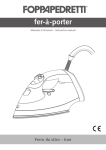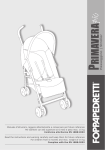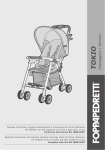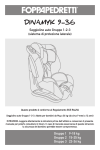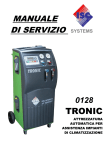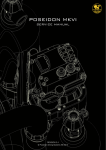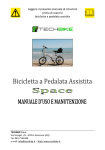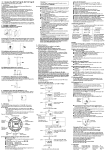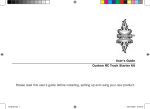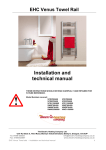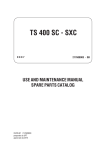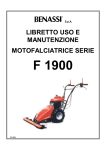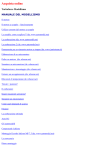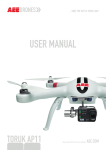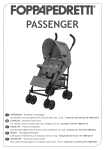Download - Cercapasseggini
Transcript
BI&BO Conforme alla norma EN 1888:2003 – (A1, A2, A3:2005) Manuale d’uso / Instruction manual IT Leggete attentamente queste istruzioni prima dell’uso e conservatele per consultazioni future. La sicurezza del vostro bambino potrebbe essere compromessa se non seguite queste istruzioni. GB Read these instructions carefully before use and keep them for future reference. Your child’s safety may be affected if you do not follow these instructions. 1 IT GUIDA DELL’UTENTE Vi ringraziamo per aver scelto questo prodotto. Dedicate qualche tempo alla lettura dei seguenti importanti avvertimenti di sicurezza. In questo modo, avrete la garanzia di usare il prodotto correttamente e in tutta sicurezza per un lungo periodo. SICUREZZA: PRENDETE NOTA ___________________________________________________________________________________________________ AVVERTENZA: SIETE RESPONSABILI DELLA SICUREZZA DEL VOSTRO BAMBINO. • Il passeggino è stato progettato per il trasporto di due bambini, ognuno del peso massimo di 15 kg. • AVVERTENZA: Il sedile anteriore non è adatto a bambini con età inferiore ai 6 mesi. Il sedile posteriore è adatto per bambini dalla nascita fino a 15 kg, utilizzare sempre e solo lo schienale completamente reclinato (orizzontale), per bambini di età inferiore ai 6 mesi. • I passeggini rappresentano un modo ideale per trasportare il vostro bambino. Tuttavia, è importante ricordare che durante i primi 3 mesi di vita, i bambini dovrebbero trascorrere la maggior parte della loro giornata in posizione supina, sia per la loro comodità, sia per il loro sviluppo. • AVVERTENZA: E’ pericoloso lasciare il vostro bambino incustodito. • AVVERTENZA: Assicurare sempre con la cintura, correttamente agganciata, il vostro bambino. • AVVERTENZA: Qualsiasi carico appeso alla maniglia pregiudica la stabilità del passeggino. • AVVERTENZA: Questo prodotto non è idoneo per essere usato da adulti che corrono o pattinano o praticano altre attività sportive similari. • I bambini devono indossare sempre le cinture di sicurezza e non devono mai essere lasciati incustoditi. • Il bambino deve essere tenuto lontano dalle parti mobili, mentre si fanno le regolazioni. • Questo prodotto richiede una manutenzione regolare da parte dell’utente. • Non utilizzate pezzi di ricambio o accessori non forniti o approvati dal fabbricante, in quanto potrebbero rendere il passeggino poco sicuro. • Un carico eccessivo, la chiusura incorretta e l’uso di accessori o componenti di ricambio non approvati potrebbero danneggiare o rompere il passeggino e potrebbero rendere il prodotto pericoloso. Leggete le istruzioni. • Non sovraccaricate il passeggino con altri bambini, merce o accessori. Le borse e altri oggetti non devono essere appesi alla maniglia. • Il passeggino è dotato di cestino per il trasporto di 3 kg di merce che deve essere distribuita in modo uniforme. • Non lasciate mai il parapioggia fissato al passeggino in casa, in un ambiente caldo o vicino ad una fonte di calore in quanto il bambino potrebbe soffrire di caldo eccessivo. • Assicuratevi che tutti gli utenti abbiano familiarità con il funzionamento del prodotto. L’apertura e la chiusura avviene facilmente, non richiede sforzi eccessivi. Se non è così, non forzate il meccanismo – fermatevi e leggete le istruzioni. • Non utilizzate il passeggino per un uso diverso da quello per il quale è stato progettato. • Assicuratevi che il vostro bambino indossi sempre le cinture di sicurezza in modo corretto e che le stesse siano ben regolate. Le cinture sono provviste di anelli a forma “D”, necessarie per il fissaggio di altre cinture, conformi alle norme BS 6684 o BS EN 13210, per la distribuzioni in mercati esteri, se richieste da un regolamento interno. • Non permettete al vostro bambino di salire, senza aiuto, nel passeggino, di giocare con il passeggino o penzolarsi dallo stesso. • Azionate sempre i freni quando il passeggino è fermo. • Tenete sempre il passeggino quando state vicino a veicoli o treni in movimento. Anche con i freni azionati, la corrente d’aria causata dal veicolo in movimento potrebbe spostare il passeggino. • State attenti quando salite o scendete da un cordolo. • Togliete i bambini e chiudete il passeggino quando salite o scendete le scale o le scale mobili. • Assicuratevi che il passeggino chiuso sia tenuto lontano dai bambini in modo che non possa cadere e causare ferite. • Non utilizzare accessori o complementi non inclusi, come per esempio seggiolini per bambini, borse, ganci, vassoi, ecc. oltre a quelli approvati dal fabbricante in quanto potrebbero rendere il passeggino poco sicuro. • Non trasportate mai un terzo bambino sul passeggino. • Non utilizzare pedane aggiuntive, per il trasporto di un bambino. • Il montaggio deve essere eseguito da una persona adulta. 2 COMPONENTI _______________________________________________________________________________________ 1 2 1. Passeggino....................... x 1 3 2. Ruote.................................x 2 4 3. Tettuccio parasole.............x 1 4. Capottina...........................x 1 5. Cesto.................................x 1 6. Spallacci imbottiti..............x 4 7. Parapioggia........................x 1 5 6 7 3 MONTAGGIO RUOTE ANTERIORI _____________________________________________________________________________________ Per fissare le ruote anteriori, spingete il gruppo ruota sulle gambe anteriori del telaio. Assicuratevi che il gruppo ruote sia fissato correttamente. La leva “A” per bloccare il movimento piroettante delle ruote deve essere orientata verso l’alto, vedere figura. “A” APRIRE IL PASSEGGINO pedale maniglia _____________________________________________________________________________________ Per aprire il vostro passeggino seguire queste fasi: Sganciare la leva di chiusura. Tenere il passeggino saldamente, afferrando entrambe le maniglie e con un piede posizionato dietro le ruote posteriori, tirare le maniglie in alto verso di voi. pedale maniglia leva di chiusura leva di chiusura ruote posteriori ruote posteriori maniglia Quando il passeggino è quasi completamente sollevato, mettete il piede sul pedale e continuate a tirare le maniglie finché il passeggino non sia completamente aperto. maniglia pedale pedale AVVERTENZA: Assicuratevi che tutti i dispositivi di bloccaggio siano agganciati prima dell’uso. 4 MONTAGGIO DEL TETTUCCIO PARASOLE _____________________________________________________________________________________ Per applicare il tettuccio parasole: Inserite gli attacchi del parasole nelle fessure sui braccioli del passeggino come indicato in figura. attacchi parasole Tenendo gli attacchi del parasole leggermente inclinati, inserite la parte anteriore di ogni attacco nella fessura sul bracciolo del passeggino. Premere verso basso e fate scorrere in avanti il dispositivo d’aggancio. Assicuratevi del corretto inserimento. Attacco parasole parte anteriore agganciare Nota: Il tettuccio parasole e la capottina hanno il dispositivo di regolazione con superficie interna dentata, è normale sentire i click durante la regolazione. Bracciolo del passeggino 5 RIMUOVERE IL TETTUCCIO PARASOLE _____________________________________________________________________________________ Per togliere il tettuccio parasole: premere sui bottoni di sgancio e far scorrere gli attacchi del parasole, verso il lato posteriore. bottone di sgancio bottone di sgancio MONTAGGIO DELLA CAPOTTINA _____________________________________________________________________________________ Per agganciare la capottina: Fissare gli agganci della capottina sul telaio del passeggino al punto di fissaggio come mostrato in figura. attacchi della capottina attacchi della capottina 6 MONTAGGIO DELLA CAPOTTINA (segue) _____________________________________________________________________________________ Tenendo gli agganci della capottina, ruotateli leggermente di circa 90°per facilitare l’aggancio al telaio del passeggino. Dopo aver calzato sul telaio gli agganci, premere e ruotarli verso l’esterno per completare il fissaggio. Assicuratevi che entrambi gli agganci, siano fissati al telaio correttamente. Per RIMUOVERE la capottina: Ruotare gli agganci della capottina leggermente verso l’interno del passeggino, di circa 90°, sollevare verso l’alto per sganciare la capottina dal telaio. attacchi capottina 7 MONTAGGIO DELLA CAPOTTINA (segue) _____________________________________________________________________________________ Quando lo schienale del sedile posteriore è completamente reclinato, si può fissare la capottina al tessuto del sedile, usando per il suo fissaggio, le strisce di Velcro che si trovano sulla parte interna della capottina e sullo schienale del sedile posteriore. Velcro Velcro 8 RECLINARE LO SCHIENALE DEL SEDILE POSTERIORE _____________________________________________________________________________________ Lo schienale del sedile posteriore è regolabile in 3 posizioni. Per abbassare lo schienale, alzare le levette su entrambi i lati del sedile e reclinarlo nella posizione desiderata. Per alzare lo schienale, basta sollevarlo nella posizione desiderata, non è necessario azionare le levette di sblocco. Quando lo schienale si trova nella posizione più reclinata, abbassata, il tessuto laterale, della seduta, si può fissare al risvolto posteriore usando le due strisce di Velcro ed i bottoni automatici,creando così uno spazio sicuro per il bambino. Schienale alzato Nota: Assicuratevi sempre che lo schienale sia ben fissato, che entrambi i dispositivi di bloccaggio siano correttamente agganciati, che tutte le regolazione siano state effettuate, prima di utilizzare il prodotto. leva Quando lo schienale è sollevato, o quando il bambino è più grande, si può fissare il risvolto posteriore, in modo che non dia fastidio, ripiegandolo sul retro dello schienale e fissandolo con le strisce di Velcro. Schienale reclinato 9 APRIRE LA CAPOTTINA E IL TETTUCCIO PARASOLE _____________________________________________________________________________________ La capottina ed il tettuccio parasole sono fornite di cerniere “snodi” da ambo i lati per consentirne l’apertura. cerniere “snodi” Per aprire il tettuccio parasole, premere verso il basso sulle cerniere come indicato in figura. 10 CHIUDERE LA CAPOTTINA E IL TETTUCCIO PARASOLE _____________________________________________________________________________________ Importante: per chiudere la capottina o il tettuccio parasole, sollevare le cerniere, da ambo i lati, e ripiegare verso la parte posteriore del passeggino la capottina ed il parasole. Non richiudere la capottina o il tettuccio parasole senza prima aver sollevato le cerniere. cerniere “snodi” Importante: quando richiudete il passeggino, reclinare verso la parte anteriore, contro il bracciolo di protezione, il tettuccio parasole 11 SGANCIARE IL BRACCIOLO DI PROTEZIONE _____________________________________________________________________________________ Il bracciolo di protezione, può essere aperto a cancelletto, per agevolare il posizionamento del bambino all’interno del passeggino o per toglierlo con più facilità. bracciolo Per sganciare il bracciolo di protezione, apertura solo sul lato destro, girare nel senso antiorario la levetta destra, posta sul lato inferiore del bracciolo, come indicato in figura e mantenendola ruotata, tirare il bracciolo aprendolo a cancelletto. bracciolo leva Per riagganciare il bracciolo, girare la levetta in senso antiorario e mantenendola ruotata agganciare il bracciolo. Lasciare la levetta. Assicurarsi del corretto aggancio. bracciolo leva 12 UTILIZZO DEI FRENI E BLOCCAGGIO DEL MOVIMENTO PIROETTANTE DELLE RUOTE ANTERIORI _____________________________________________________________________________________ Per azionare i freni, premere con il piede sulla leva del freno destra o sinistra, finché il meccanismo non azioni il dispositivo frenante. Verificare che i freni siano azionati, spingendo dolcemente in avanti il passeggino. Per sbloccare il dispositivo frenante, sollevare, con il piede, la leva dei freni destra o sinistra. Per sicurezza azionare sempre i freni prima di collocare o rimuovere il bambino dal passeggino. leva del freno ll passeggino è dotato di ruote anteriori piroettanti, che possono essere bloccate. Per bloccare il movimento piroettante, premere entrambe le leve verso il basso e spingere il passeggino leggermente in avanti, quando le ruote si troveranno allineate nel senso longitudinale, avrete il bloccaggio delle ruote. Per sbloccare le ruote, sollevare entrambe le leve verso l’alto. leva di bloccaggio 13 L’USO DELLA CINTURA “IMBRACATURA” ____________________________________________________________________________________ AVVERTENZA La cintura a 5 punti, deve sempre essere usata correttamente agganciata, corpo sparti gambe, cinture girovita, cinture pettorali. Per allacciare la cintura: Spingete le estremità di ogni cintura (A) nella fibbia (B) fino allo scatto, in questo modo la cintura girovita e il corpo sparti gambe saranno correttamente agganciate e bloccate. A Le cinture pettorali devono sempre essere agganciate all’anello, presente sul corpo di plastica, dell’estremità della cintura girovita. B A Per slacciare la cintura: Premete contemporaneamente le estremità di ogni cinghia (A), questo consentirà lo sgancio delle cinture dalla fibbia (B). L’imbracatura, sia in dotazione al sedile anteriore, sia in dotazione al sedile posteriore, è regolabile per adattarsi perfettamente alla corporatura del bambino. B C Per regolare le cinture, è sufficiente agire sui regolatori (C) facendoli scorrere lungo la cintura per ottenere la regolazione idonea alla corporatura del vostro bambino. C Le cinture potrebbero essere dotate di anelli a “D” da utilizzare per eventuali cinture in conformità alle norme BS EN 13210, richieste in mercati esteri. 14 UTILIZZO DEL POGGIAPIEDI PER IL SEDILE POSTERIORE _____________________________________________________________________________________ Il sedile posteriore del vostro passeggino è dotato di poggiapiedi a scomparsa che può essere fissato con strisce di Velcro e bottoni automatici. bottoni automatici Velcro Man mano che il vostro bambino cresce e richiede più spazio per le gambe, il poggiapiedi può essere ripiegato sotto il sedile posteriore, si fissa con strisce di Velcro. FISSARE E TOGLIERE IL CESTO INFERIORE ____________________________________________________________________________________ cinghia Si fissa e si toglie il cesto inferiore, sotto il passeggino, tramite i bottoni automatici posti sulle 4 cinghie del cesto. cinghia lato con rete 15 FISSARE E TOGLIERE IL CESTO INFERIORE continua _____________________________________________________________________________________ Il cesto inferiore può essere fissato in un senso o nell’altro a condizione che la parte con la rete sia sempre a lato del passeggino. Infilate le cinghie intorno al telaio del passeggino e agganciate i bottoni automatici. rete rete FISSARE IL PARAPIOGGIA _____________________________________________________________________________________ fessura Per fissare il parapioggia, infilate la fessura che si trova sulla parte alta del parapioggia sopra le maniglie del passeggino. Fissate i lati del parapioggia utilizzando le strisce in Velcro in dotazione. fessura Velcro Velcro Velcro Velcro 16 Velcro Velcro CHIUDERE IL PASSEGGINO _____________________________________________________________________________________ Prima di procedere con la chiusura del passeggino, con la capottina o il parasole montati, assicuratevi che gli stessi siano piegati come mostrato in figura, la capottina ripiegata indietro ed il parasole piegato in avanti. PER CHIUDERE IL PASSEGGINO continua _____________________________________________________________________________________ Per chiudere il passeggino, tirate verso alto la maniglia posteriore finché il passeggino non inizia a piegarsi. Non forzare sul passeggino. Tirare entrambe le leve di sgancio verso l’alto e contemporaneamente spingete le maniglie in avanti e il passeggino si chiuderà. leva di sgancio maniglia posteriore Bloccate il passeggino agganciando la leva di chiusura. leva di chiusura 17 ATTENZIONE • Il vostro passeggino soddisfa i requisiti previsti dalle norme di sicurezza e con un uso corretto e un’adeguata manutenzione manterrà le sue prestazioni inalterate per diversi anni. • Il telaio è robusto ma può danneggiarsi se le ruote posteriori continuano ad essere sottoposte a forti impatti scendendo gradini o cordoli. Gli impatti continui causeranno dei danni. • Se il vostro bambino indossa scarpe dure, queste potrebbero danneggiare il tessuto morbido. • Riporre il passeggino bagnato, può causare la formazione di muffa. • Se il passeggino è esposto all’umidità, o bagnato, asciugatelo con un panno morbido, aprite completamente il passeggino e lasciatelo asciugare prima di riporlo. • Tenete il vostro passeggino in un luogo asciutto e sicuro. • Non lasciate il passeggino al sole per periodi prolungati – alcuni tessuti potrebbero sbiadirsi. MANUTENZIONE • Questo passeggino richiede una manutenzione regolare da parte dell’utente. • Il prodotto richiede un minino di manutenzione. La lubrificazione delle parti in movimento aumenterà la durata del passeggino e renderà più facile le operazioni di apertura e chiusura dello stesso. • Se alcune parti del passeggino dovessero diventare rigide o difficile da far funzionare, applicate una piccola quantità di lubrificante in forma di spray, per esempio WD 40. Non utilizzate olio o grasso. • Il prodotto WD 40 non deve essere usato per lubrificare le ruote estraibili. Se necessario, le ruote devono essere rimosse e pulite con un panno morbido e asciutto. • Controllate regolarmente i dispositivi di bloccaggio, i freni, le ruote, le cinghie, le levette, i regolatori dei sedili, le giunture ed i dispositivi di fissaggio, assicurandosi sempre che siano correttamente agganciati e in buone condizioni di funzionamento. • I freni, le ruote e le gomme sono soggetti ad usura e devono essere sostituiti all’occorrenza. • Eseguire un controllo accurato, sul corretto funzionamento del passeggino, dopo 18 mesi di utilizzo, dopo un lungo periodo di non utilizzo e prima di utilizzarlo per un secondo bambino. PULIZIA • I sedili, la fodera del frontalino, il tettuccio e la capottina possono essere puliti con acqua tiepida, un detergente neutro e una spugna. • Le parti in plastica e in metallo possono essere pulite con acqua tiepida, un detergente neutro e una spugna. • Non utilizzare mai prodotti per la pulizia abrasivi o a base di ammoniaca, candeggina o acquaragia. 18 GB USER GUIDE thank you for choosing our product. Please take a little time to read the important safety notes detailed below. this will ensure many years of happy, safe use. _________________________________________________________________________________________________________________ SAFETY: TAKE NOTE WARNING: A CHILDS SAFETY IS YOUR RESPONSIBILITY • This pushchair is designed to carry two children, each with a maximum weight of 15kg. • WARNING: The front seat is not suitable for children under 6 months. The rear seat is suitable from birth to 15kg, always use the backrest completely lowered for children under the age of 6 months. • Pushchairs are an ideal way of transporting your baby. It is important to remember, however, that during the first 3 months babies should be spending most of their day lying flat, for comfort and development. • WARNING: It may be dangerous to leave your child unattended. • WARNING: Always use the harness, correctly fastened, to secure your child when in the pushchair. • WARNING: Any load attached to the handle affects the stability of the pushchair. • WARNING: This product is not suitable for running or skating. • Children should be harnessed in at all times and never left unattended. • The child should be clear of moving parts while making adjustments. •This vehicle requires regular maintenance by the user. • Do not use replacement parts or accessories other than those approved by the supplier as they may render the pushchair unsafe. • Overloading, incorrect folding, and the use of non-approved accessories or spare parts may damage or break this pushchair and could render the product unsafe. Read the instructions. • Do not overload this pushchair with additional children, goods or accessories. Bags and other items must not be hung from the handle. A basket is provided for the carriage of 3kg (6.6lb.) of goods, evenly distributed. • Never leave rain covers on indoors, in a hot atmosphere or near a heat source as the baby could overheat. • Ensure all users are familiar with the products operation. It should always open and fold easy. If it does not, do not force the mechanism - stop and read the instructions. • Do not use your pushchair in a manner for which it is not designed. • Ensure your child wears a correctly fitted and adjusted harness at all times. D-rings are provided on the existing harness for the attachment of a separate safety harness approved to BS 6684 or BS En 13210 should this be required. • Do not allow your child to climb unassisted into, play with or hang onto your pushchair. • Always apply the brakes when the pushchair is stationary. • Hold on to your pushchair when close to moving road vehicles or trains. Even with the brake on the draught from the vehicle may move the pushchair. • Exercise caution when mounting or dismounting a kerb. • Remove your children and fold the pushchair when ascending or descending stairs or escalators. • Ensure the folded pushchair is stored away from children so that it does not fall and cause injury. • Do not use replacement parts or accessories, e.g. child seats, bags, hooks, trays, rain covers etc. other than those approved by the supplier, they may render the pushchair unsafe. • Never carry a third child on your pushchair. • Do not use any platforms or attachments that allow transportation of third child. • The product must be assebled by an adult. 19 LIST OF PARTS _____________________________________________________________________________________ 1 2 1. Pushchair..............................x1 3 2. Wheels.................................x2 4 3. Front Hood..........................x1 4. Rear Hood...........................x1 5. Basket..................................x1 6. Harness Pads.......................x4 7. Rain cover............................x1 5 6 7 20 ATTACHING THE FRONT WHEELS _____________________________________________________________________________________ To fit the front wheels, push each wheel assembly on to the front legs, ensuring that they engage securely. The dimpled surface of the swivel lock levers “A“ should face upwards when fitting. “A” HOW TO OPEN YOUR PUSHCHAIR foot pedal handles _____________________________________________________________________________________ In order to unfold your pushchair first release the folding lock. Next hold the pushchair firmly by both handles and with a foot placed behind the rear wheels pull the handles upwards towards you. foot pedal handles folding lock rear wheels folding lock rear wheels handles handles foot pedal When nearly all the way up place your foot on the foot pedal and continue pulling the handles till the pushchair is fully erect. foot pedal WARNING: Ensure that all locking devices are engaged before use. 21 ATTACHING THE FRONT HOOD _____________________________________________________________________________________ To attach the front hood: insert the hood clips into the slots on the pushchair arms as indicated below. hood clips Holding the hood clips at a slight angle insert the front of each hood clip into the slot on the pushchair arm, then push down and forward to secure. Hood Clip front slot Note: The front and rear hoods operate differently from one another. The front hood contains a ratchet system and the clicking noises, heard whilst adjusting it, are normal. Pushchair Arm 22 ATTACHING THE FRONT HOOD continued _____________________________________________________________________________________ To detach the front hood: press down on the release buttons then pull the hood clips backwards. release button release button ATTACHING THE REAR HOOD _____________________________________________________________________________________ To attach the rear hood: fix the hood clips on to the pushchair frame at the fixing point as indicated on page 5. hood clips hood clips 23 ATTACHING THE REAR HOOD continued _____________________________________________________________________________________ Holding the hood clips, twist them slightly to allow ease of attachment to the pushchair frame. Slip the hood clips over the fixing point then push on and twist into place. To detach: twist the hood clips slightly inwards towards the centre of the pushchair then remove from the chassis. hood clips 24 ATTACHING THE REAR HOOD continued ____________________________________________________________________________________ When the back seat is reclined the rear hood can fasten to the seat fabric by means of Velcro strips located on the underside of the hood and back of the rear seat. Velcro Velcro 25 ADJUSTING THE REAR SEAT BACK _____________________________________________________________________________________ The rear seat has 3 recline positions. To lower the back rest lift the catches on both sides of the seat and position as required. To raise simply push the backrest forwards to the desired position. Once the back rest is in its reclined position the sides of the pushchair can be attached to the rear flap using the two Velcro strips and press studs to create a secure space for the infant. Back raised Note: Always ensure the backrest is secure and the necessary adjustments are made prior to use. catch When the back seat is raised or when the infant is older the rear flap can be secured out of the way by folding back and securing with the Velcro strips. Back lowered 26 OPENING THE HOODS _____________________________________________________________________________________ Both hoods can be opened by hinges on either side of each hood. hinges To open the front hood push down on the hinges as indicated. 27 CLOSING THE HOODS _____________________________________________________________________________________ Both hoods can be folded back by lifting the hinges on either side of each and pushing the hood frame backwards. hinges If folding the pushchair, push the front hood forwards against the armrests. 28 UNLOCKING AND LOCKING THE BUMPER BAR _____________________________________________________________________________________ The front bumper bar can be opened for ease of placing and removing your infant from the pushchair. bumper bar To open the bumper bar turn the lever to the right as indicated by the arrow. Whilst holding the lever in this position pull on the bumper bar to free it. bumper bar lever To close the bumper bar again, turn the lever to the right as indicated by the arrow and push the bumper bar back into place. Letting go of the lever will lock the bar safely in position. bumper bar lever 29 THE BRAKES AND WHEEL LOCKS _____________________________________________________________________________________ Using your foot, push down on either brake pedal till the mechanism clicks into place, engaging the brakes. Check the brakes are securely engaged by gently pushing forwards against the pushchair handles. To disengage the brakes place your toe under either brake pedal and ease it upwards to free the brakes. For their safety, the brakes must be engaged before loading or unloading children. brake pedals Your pushchair is equipped with lockable swivel wheels. To lock the front wheels push down on both swivel locking pedals. To unlock: lift both pedals. pedals 30 USING THE HARNESS _____________________________________________________________________________________ WARNING Always use the crotch strap in combination with the waist belt. Fastening the harness: Push the ends of each strap (A) into the buckle (B) until they click into place locking the waist and crotch straps together. A B Releasing the harness: Press together the ends of each strap (A)allowing the straps to be slid out from the buckle (B). A B All straps on both front and rear harnesses can be fully adjusted to securely fit your infant. To adjust the straps simply slide the adjusters (C) up or down till the required size is found. ‘D’ rings are fitted should you wish to attach a separate harness complying with BS EN 13210. C C 31 REAR SEAT FOOT-REST _____________________________________________________________________________________ The rear seat of your pushchair comes with a fold-away foot-rest which can be attached via strips of Velcro and press studs. press studs press studs Velcro Velcro As your infant grows and requires more leg room the footrest can be detached and folded back under the rear seat where it attaches to more Velcro strips. ATTACHING AND DETACHING THE BASKET _____________________________________________________________________________________ The basket can be attached and detached from underneath the pushchair by means of the press studs on the basket’s 4 straps. strap strap mesh mesh strap strap 32 ATTACHING AND DETACHING THE BASKET continued _____________________________________________________________________________________ The basket can be attached any way round provided the mesh is at the side of the pushchair. mesh Thread the straps around the pushchair frame and secure the press studs. ATTACHING THE RAINCOVER _____________________________________________________________________________________ Your pushchair comes complete with a simple and quick attaching raincover. To attach the cover simply slide the slot located in the top of the cover over the pushchair handles. slot Secure the sides of the rain cover using the Velcro straps provided. Velcro ® Velcro ® FOLDING THE PUSHCHAIR _____________________________________________________________________________________ If folding the pushchair with the hoods attached ensure hoods are folded as shown with the rear hood folded back and front hood folded forward. 33 FOLDING THE PUSHCHAIR continued _____________________________________________________________________________________ To fold your pushchair pull the rear handle upwards till the pushchair begins to fold DO NOT FORCE IT. Whilst pulling up on the release catches push the handles away from you folding the pushchair. release catches rear handle Secure the pushchair with the folding lock. folding lock 34 CARE • Your pushchair has been designed to meet safety standards and with correct use and maintenance will give many years of trouble free performance. • The chassis is strong but will weaken should the back wheels be bumped down stairs or kerbs. continual impact will cause damage. • If your child wears hard shoes these might damage the soft fabric. • Storing a damp pushchair will encourage mildew to form. • After exposure to damp conditions, dry off with a soft cloth, open fully and allow to dry thoroughly before storing. • Store your pushchair in a dry, safe place. • Do not leave the pushchair in sunlight for prolonged periods - some fabrics may fade. MAINTENANCE • This pushchair requires regular maintenance by the user. • This product is designed to operate with minimum maintenance, however regular lubrication of moving parts will extend the life of your pushchair and make opening and folding easier. • Should parts of your pushchair become stiff or difficult to operate, apply a light application of a spray lubricant e.g. WD 40. Do not use oil or grease. • WD 40 should not be used to lubricate the running of removable wheels. If necessary, these should be removed and cleaned with a soft dry cloth. • Regularly inspect the locking devices, brakes, wheels, harness assembly, catches, seat adjusters, joints and fixings to ensure they are secure and in full working order. • Brakes, wheels and tyres are subject to wear and should be replaced if necessary. • Your pushchair should be serviced and reconditioned before using it for a second baby, or within 18 months, whichever is the sooner. CLEANING • The seat units, bumper bar cover and hoods may be cleaned by sponging lightly using warm water and a mild detergent. • Plastic and metal parts may be sponged clean with warm water and a mild detergent. • Never clean with abrasive, ammonia based, bleach based or spirit type cleaners. 35 Made in China R1 BI & BO Distribuito da: Foppa Pedretti S.p.A. via Volta, 11 24064 Grumello del Monte, BG - Italy tel +39 035 830497 fax + 39 035.831283 www.foppapedretti.it 36





































